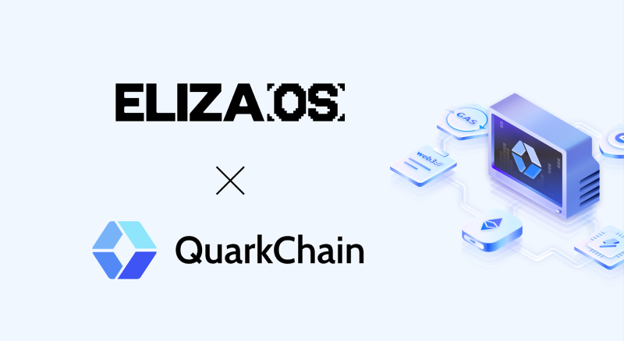Blockchain and AI Integration: How On-Chain AI Agents Will Shape the Future
In recent years, the intersection of blockchain and artificial intelligence (AI) has become a focal point for technological innovation. Recently, QuarkChain, a high-performance sharded blockchain, and Eliza Labs, an open-source AI operating system, announced a strategic partnership aimed at achieving fully on-chain AI agents. This collaboration is not just a technical integration but a significant exploration into the automation and intelligence of decentralized ecosystems.

The Core Value of On-Chain AI Agents
In traditional blockchain ecosystems, complex operations such as liquidity pool management and cross-chain transactions often require users to possess specialized knowledge. The introduction of on-chain AI agents significantly reduces entry barriers by enabling natural language interaction, automated decision-making, and cross-chain coordination. For example, Eliza has developed an interactive Telegram bot that explains the logic behind yield farming and even assists users in formulating personalized strategies. This “AI translation layer” makes blockchain technology accessible to the general public.
For developers, the implications of on-chain AI agents are even more profound. Eliza’s modular system allows developers to customize AI roles for different scenarios—whether it’s social media customer service, DeFi strategy advisors, or multi-chain asset management tools (such as the JuCoin cross-chain bridge tool)—all of which can be quickly deployed via adapters and plugins. QuarkChain’s high-throughput sharded technology provides the necessary infrastructure for cross-chain execution of these AI agents, ensuring efficient completion of complex tasks.
Technological Breakthroughs and Application Scenarios
The realization of on-chain AI agents relies on two key technologies:
-
Tree-of-Thoughts: This allows AI to explore multiple solutions simultaneously and select the optimal path. For example, when analyzing market fluctuations, AI can combine historical data with real-time on-chain information to predict asset prices.
-
Retrieval-Augmented Generation (RAG): By calling on-chain contracts and databases, this ensures the accuracy and timeliness of the AI outputs.
In the DeFi sector, the application of this technology is already yielding results. AI agents can monitor liquidity pools across multiple chains and automatically balance users’ portfolios to maximize returns. For example, when gas fees on the Ethereum network surge, the AI may suggest users switch their transactions to QuarkChain or another low-fee chain. This dynamic optimization ability could lead to exponential growth in DeFi transaction volumes.
Social media and community management is another potential application. AI agents can interact with users via platforms like Twitter or Discord, generating personalized content based on on-chain behavioral data. For example, the AI customer service for an NFT project could automatically answer holders’ questions about staking rules and rights, or even recommend related airdrop activities based on the user’s wallet history.
Challenges and Future Outlook
Despite its promising potential, on-chain AI agents face multiple challenges:
-
Data Privacy: AI needs to access user wallet addresses and transaction history to provide services, which could raise concerns about sensitive information leakage. Currently, the Eliza team is exploring zero-knowledge proof (ZKP) technology to create a “usable but invisible” data processing model.
-
Complexity of Cross-Chain Collaboration: Protocol differences between blockchains could lead to decision delays or errors by AI agents. QuarkChain and Eliza’s solution is to establish a unified middle-layer standard that “translates” the smart contract interfaces of various chains into universal instructions that AI can understand, thereby reducing development costs for multi-chain operations.
Looking ahead, on-chain AI agents could become the “automation engine” of the blockchain ecosystem. In the future, users may only need to send a single instruction to the AI (e.g., “swap ETH to USDC on the Solana chain with the lowest cost”), and the AI agent would automatically handle cross-chain routing, price comparison, and transaction execution. This seamless experience will be a crucial step for blockchain technology to achieve mainstream adoption.
The Next Decade of Technological Integration
The collaboration between QuarkChain and Eliza marks the shift from proof of concept to actual implementation of blockchain and AI integration. As on-chain AI agents penetrate various sectors such as DeFi, gaming, and social media, a smarter and more interconnected Web3 ecosystem is taking shape. For ordinary users, this means simpler operations and higher returns; for developers, it lays the groundwork for building the next generation of decentralized applications.
Technological progress never stops, and on-chain AI agents may be the key to unlocking the future. They not only redefine the way humans and machines interact, but also enable blockchain’s potential to go beyond its code, truly serving the real needs of global users.




